Munson B.R. Fundamentals of Fluid Mechanics
Подождите немного. Документ загружается.

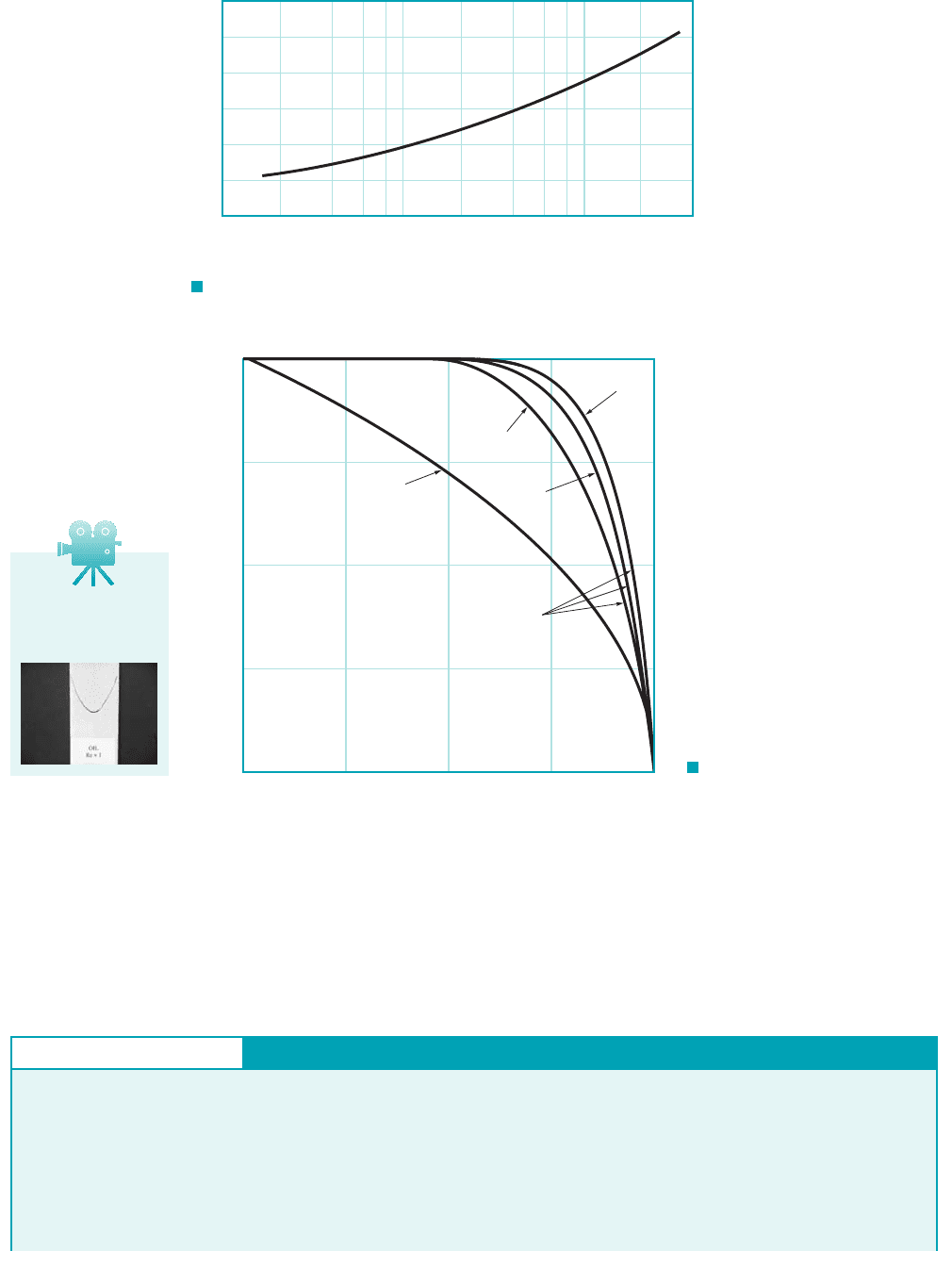
reasonable approximate results are often obtained by using the inviscid Bernoulli equation and by
assuming a fictitious uniform velocity profile. Since most flows are turbulent and turbulent flows
tend to have nearly uniform velocity profiles, the usefulness of the Bernoulli equation and the uni-
form profile assumption is not unexpected. Of course, many properties of the flow cannot be ac-
counted for without including viscous effects.
8.3 Fully Developed Turbulent Flow 407
11
10
9
8
n
7
5
10
4
Re =
VD
____
ρ
μ
10
5
10
6
6
F I G U R E 8.17 Exponent, n, for power-law velocity profiles.
(Adapted from Ref. 1.)
F I G U R E 8.18
Typical laminar flow and
turbulent flow velocity
profiles.
1.0
0.5
0
0 0.5 1.0
Turbulent
Laminar
n = 8
n = 6
n = 10
r
_
_
R
_
u
__
V
c
V8.9 Laminar/
turbulent velocity
profiles
GIVEN Water at and
flows through a horizontal pipe of 0.1-m diameter
with a flowrate of and a pressure gradient of
2.59 kPa m.
FIND (a) Determine the approximate thickness of the vis-
cous sublayer.
Q 4 10
2
m
3
s
10
6
m
2
s2
n 1.004 20 °C 1r 998 kg
m
3
Turbulent Pipe Flow Properties
E
XAMPLE 8.4
(b) Determine the approximate centerline velocity,
(c) Determine the ratio of the turbulent to laminar shear stress,
at a point midway between the centerline and the pipe
wall 1i.e., at r 0.025 m2.
t
turb
t
lam
,
V
c
.
JWCL068_ch08_383-460.qxd 9/23/08 10:52 AM Page 407

408 Chapter 8 ■ Viscous Flow in Pipes
S
OLUTION
obtained by integration of the power-law velocity profile as fol-
lows. Since the flow is axisymmetric,
which can be integrated to give
Thus, since we obtain
With in the present case, this gives
(Ans)
Recall that for laminar pipe flow.
(c) From Eq. 8.4, which is valid for laminar or turbulent flow,
the shear stress at is
or
where From the power-law velocity profile
1Eq. 8.312we obtain the gradient of the average velocity as
which gives
Thus,
Thus, the ratio of turbulent to laminar shear stress is given by
(Ans)
COMMENT As expected, most of the shear stress at this lo-
cation in the turbulent flow is due to the turbulent shear stress.
t
turb
t
lam
⫽
t ⫺ t
lam
t
lam
⫽
32.4 ⫺ 0.0266
0.0266
⫽ 1220
⫽ 0.0266 N
Ⲑ
m
2
⫽⫺11.004 ⫻ 10
⫺6
m
2
Ⲑ
s21998 kg
Ⲑ
m
3
21–26.5
Ⲑ
s2
t
lam
⫽⫺m
du
dr
⫽⫺1nr2
du
dr
⫽⫺26.5
Ⲑ
s
du
dr
⫽⫺
16.04 m
Ⲑ
s2
8.410.05 m2
a1 ⫺
0.025 m
0.05 m
b
11⫺8.42
Ⲑ
8.4
du
dr
⫽⫺
V
c
nR
a1 ⫺
r
R
b
11⫺n2
Ⲑ
n
t
lam
⫽⫺m du
Ⲑ
dr.
t ⫽ t
lam
⫹ t
turb
⫽ 32.4 N
Ⲑ
m
2
t ⫽
2t
w
r
D
⫽
2164.8 N
Ⲑ
m
2
210.025 m2
10.1 m2
r ⫽ 0.025 m
V
c
⫽ 2V
⫽ 6.04 m
Ⲑ
s
V
c
⫽
1n ⫹ 1212n ⫹ 12
2n
2
V ⫽ 1.186V ⫽ 1.186 15.09 m
Ⲑ
s2
n ⫽ 8.4
V
V
c
⫽
2n
2
1n ⫹ 1212n ⫹ 12
Q ⫽ pR
2
V,
Q ⫽ 2pR
2
V
c
n
2
1n ⫹ 1212n ⫹ 12
Q ⫽ AV ⫽
冮
u dA ⫽ V
c
冮
r⫽R
r⫽0
a1 ⫺
r
R
b
1
Ⲑ
n
12pr2 dr
(a) According to Fig. 8.16, the thickness of the viscous sub-
layer, is approximately
Therefore,
where
(1)
The wall shear stress can be obtained from the pressure drop data
and Eq. 8.5, which is valid for either laminar or turbulent flow.
Thus,
Hence, from Eq. 1 we obtain
so that
(Ans)
COMMENT As stated previously, the viscous sublayer is
very thin. Minute imperfections on the pipe wall will protrude
into this sublayer and affect some of the characteristics of the
flow 1i.e., wall shear stress and pressure drop2.
(b) The centerline velocity can be obtained from the average
velocity and the assumption of a power-law velocity profile as
follows. For this flow with
the Reynolds number is
Thus, from Fig. 8.17, so that
To determine the centerline velocity, we must know the re-
lationship between V 1the average velocity2and This can beV
c
.
V
c
,
u
V
c
⬇ a1 ⫺
r
R
b
1
Ⲑ
8.4
n ⫽ 8.4
Re ⫽
VD
n
⫽
15.09 m
Ⲑ
s210.1 m2
11.004 ⫻ 10
⫺6
m
2
Ⲑ
s2
⫽ 5.07 ⫻ 10
5
V ⫽
Q
A
⫽
0.04 m
3
Ⲑ
s
p10.1 m2
2
Ⲑ
4
⫽ 5.09 m
Ⲑ
s
⫽ 1.97 ⫻ 10
⫺5
m ⯝ 0.02 mm
d
s
⫽
511.004 ⫻ 10
⫺6
m
2
Ⲑ
s2
0.255 m
Ⲑ
s
u* ⫽ a
64.8 N
Ⲑ
m
2
998 kg
Ⲑ
m
3
b
1
Ⲑ
2
⫽ 0.255 m
Ⲑ
s
t
w
⫽
D ¢p
4/
⫽
10.1 m212.59 ⫻ 10
3
N
Ⲑ
m
2
2
411 m2
⫽ 64.8 N
Ⲑ
m
2
u* ⫽ a
t
w
r
b
1
Ⲑ
2
d
s
⫽ 5
n
u*
d
s
u*
n
⫽ 5
d
s
,
The turbulent flow characteristics discussed in this section are not unique to turbulent flow in
round pipes. Many of the characteristics introduced 1i.e., the Reynolds stress, the viscous sublayer, the
overlap layer, the outer layer, the general characteristics of the velocity profile, etc.2are found in other
turbulent flows. In particular, turbulent pipe flow and turbulent flow past a solid wall 1boundary layer
flow2share many of these common traits. Such ideas are discussed more fully in Chapter 9.
JWCL068_ch08_383-460.qxd 9/23/08 10:52 AM Page 408

8.3.4 Turbulence Modeling
Although it is not yet possible to theoretically predict the random, irregular details of turbulent
flows, it would be useful to be able to predict the time-averaged flow fields 1pressure, velocity, etc.2
directly from the basic governing equations. To this end one can time average the governing Navier–
Stokes equations 1Eqs. 6.31 and 6.1272to obtain equations for the average velocity and pressure.
However, because the Navier–Stokes equations are nonlinear, the resulting time-averaged differ-
ential equations contain not only the desired average pressure and velocity as variables, but also
averages of products of the fluctuations—terms of the type that one tried to eliminate by averag-
ing the equations! For example, the Reynolds stress 1see Eq. 8.262occurs in the time-
averaged momentum equation.
Thus, it is not possible to merely average the basic differential equations and obtain govern-
ing equations involving only the desired averaged quantities. This is the reason for the variety of
ad hoc assumptions that have been proposed to provide “closure” to the equations governing the
average flow. That is, the set of governing equations must be a complete or closed set of equa-
tions—the same number of equation as unknowns.
Various attempts have been made to solve this closure problem 1Refs. 1, 322. Such schemes
involving the introduction of an eddy viscosity or the mixing length 1as introduced in Section
8.3.22are termed algebraic or zero-equation models. Other methods, which are beyond the scope
of this book, include the one-equation model and the two-equation model. These turbulence
models are based on the equation for the turbulence kinetic energy and require significant com-
puter usage.
Turbulence modeling is an important and extremely difficult topic. Although considerable
progress has been made, much remains to be done in this area.
8.3.5 Chaos and Turbulence
Chaos theory is a relatively new branch of mathematical physics that may provide insight into the com-
plex nature of turbulence. This method combines mathematics and numerical 1computer2techniques
to provide a new way to analyze certain problems. Chaos theory, which is quite complex and is cur-
rently under development, involves the behavior of nonlinear dynamical systems and their response to
initial and boundary conditions. The flow of a viscous fluid, which is governed by the nonlinear Navier–
Stokes equations 1Eq. 6.1272, may be such a system.
To solve the Navier–Stokes equations for the velocity and pressure fields in a viscous flow, one
must specify the particular flow geometry being considered 1the boundary conditions2and the condi-
tion of the flow at some particular time 1the initial conditions2. If, as some researchers predict, the
Navier– Stokes equations allow chaotic behavior, then the state of the flow at times after the initial
time may be very, very sensitive to the initial conditions. A slight variation to the initial flow condi-
tions may cause the flow at later times to be quite different than it would have been with the original,
only slightly different initial conditions. When carried to the extreme, the flow may be “chaotic,” “ran-
dom,” or perhaps 1in current terminology2, “turbulent.”
The occurrence of such behavior would depend on the value of the Reynolds number. For
example, it may be found that for sufficiently small Reynolds numbers the flow is not chaotic 1i.e.,
it is laminar2, while for large Reynolds numbers it is chaotic with turbulent characteristics.
Thus, with the advancement of chaos theory it may be found that the numerous ad hoc tur-
bulence ideas mentioned in previous sections 1i.e., eddy viscosity, mixing length, law of the wall,
etc.2may not be needed. It may be that chaos theory can provide the turbulence properties and
structure directly from the governing equations. As of now we must wait until this exciting topic
is developed further. The interested reader is encouraged to consult Ref. 4 for a general introduc-
tion to chaos or Ref. 33 for additional material.
⫺ru¿v¿
8.4 Dimensional Analysis of Pipe Flow 409
As noted previously, turbulent flow can be a very complex, difficult topic—one that as yet has
defied a rigorous theoretical treatment. Thus, most turbulent pipe flow analyses are based on
experimental data and semi-empirical formulas. These data are expressed conveniently in dimen-
sionless form.
8.4 Dimensional Analysis of Pipe Flow
Chaos theory may
eventually provide a
deeper understand-
ing of turbulence.
JWCL068_ch08_383-460.qxd 9/23/08 10:52 AM Page 409

It is often necessary to determine the head loss, , that occurs in a pipe flow so that the
energy equation, Eq. 5.84, can be used in the analysis of pipe flow problems. As shown in Fig.
8.1, a typical pipe system usually consists of various lengths of straight pipe interspersed with
various types of components (valves, elbows, etc.). The overall head loss for the pipe system con-
sists of the head loss due to viscous effects in the straight pipes, termed the major loss and denoted
, and the head loss in the various pipe components, termed the minor loss and denoted
. That is,
The head loss designations of “major” and “minor” do not necessarily reflect the relative impor-
tance of each type of loss. For a pipe system that contains many components and a relatively
short length of pipe, the minor loss may actually be larger than the major loss.
8.4.1 Major Losses
A dimensional analysis treatment of pipe flow provides the most convenient base from which to
consider turbulent, fully developed pipe flow. An introduction to this topic was given in Section
8.3. As is discussed in Sections 8.2.1 and 8.2.4, the pressure drop and head loss in a pipe are de-
pendent on the wall shear stress, between the fluid and pipe surface. A fundamental difference
between laminar and turbulent flow is that the shear stress for turbulent flow is a function of the
density of the fluid, For laminar flow, the shear stress is independent of the density, leaving the
viscosity, as the only important fluid property.
Thus, as indicated by the figure in the margin, the pressure drop, for steady, incompress-
ible turbulent flow in a horizontal round pipe of diameter D can be written in functional form as
(8.32)
where V is the average velocity, is the pipe length, and is a measure of the roughness of the
pipe wall. It is clear that should be a function of V, D, and The dependence of on the
fluid properties and is expected because of the dependence of on these parameters.
Although the pressure drop for laminar pipe flow is found to be independent of the roughness
of the pipe, it is necessary to include this parameter when considering turbulent flow. As is dis-
cussed in Section 8.3.3 and illustrated in Fig. 8.19, for turbulent flow there is a relatively thin vis-
cous sublayer formed in the fluid near the pipe wall. In many instances this layer is very thin;
where is the sublayer thickness. If a typical wall roughness element protrudes suffi-
ciently far into 1or even through2this layer, the structure and properties of the viscous sublayer 1along
with and 2will be different than if the wall were smooth. Thus, for turbulent flow the pres-
sure drop is expected to be a function of the wall roughness. For laminar flow there is no thin vis-
cous layer—viscous effects are important across the entire pipe. Thus, relatively small roughness
elements have completely negligible effects on laminar pipe flow. Of course, for pipes with very large
wall “roughness” such as that in corrugated pipes, the flowrate may be a function of
the “roughness.” We will consider only typical constant diameter pipes with relative roughnesses in
the range Analysis of flow in corrugated pipes does not fit into the standard con-
stant diameter pipe category, although experimental results for such pipes are available 1Ref. 302.
The list of parameters given in Eq. 8.32 is apparently a complete one. That is, experiments
have shown that other parameters 1such as surface tension, vapor pressure, etc.2do not affect the
pressure drop for the conditions stated 1steady, incompressible flow; round, horizontal pipe2. Since
there are seven variables which can be written in terms of the three reference dimensions
MLT Eq. 8.32 can be written in dimensionless form in terms of dimensionless
groups. As was discussed in Section 7.9.1, one such representation is
This result differs from that used for laminar flow 1see Eq. 8.172in two ways. First, we have cho-
sen to make the pressure dimensionless by dividing by the dynamic pressure, rather than a
characteristic viscous shear stress, This convention was chosen in recognition of the fact
that the shear stress for turbulent flow is normally dominated by which is a stronger functiont
turb
,
mV
D.
rV
2
2,
¢p
1
2
rV
2
f
~
a
rVD
m
,
/
D
,
e
D
b
k r 41r 32,
1k 72
0 e
D f 0.05.
1e
D g 0.12,
t
w
¢p
d
s
d
s
D 1,
trm
¢p/.¢p
e/
¢p F1V, D, /, e, m, r2
¢p,
m,
r.
t
w
,
h
L
h
L major
h
L minor
h
L minor
h
L major
h
L
410 Chapter 8 ■ Viscous Flow in Pipes
(1) (2)
D
ε
V
ρ, μ
ᐉ
Δp
= p
1
– p
2
Turbulent pipe flow
properties depend
on the fluid density
and the pipe rough-
ness.
JWCL068_ch08_383-460.qxd 9/23/08 10:52 AM Page 410
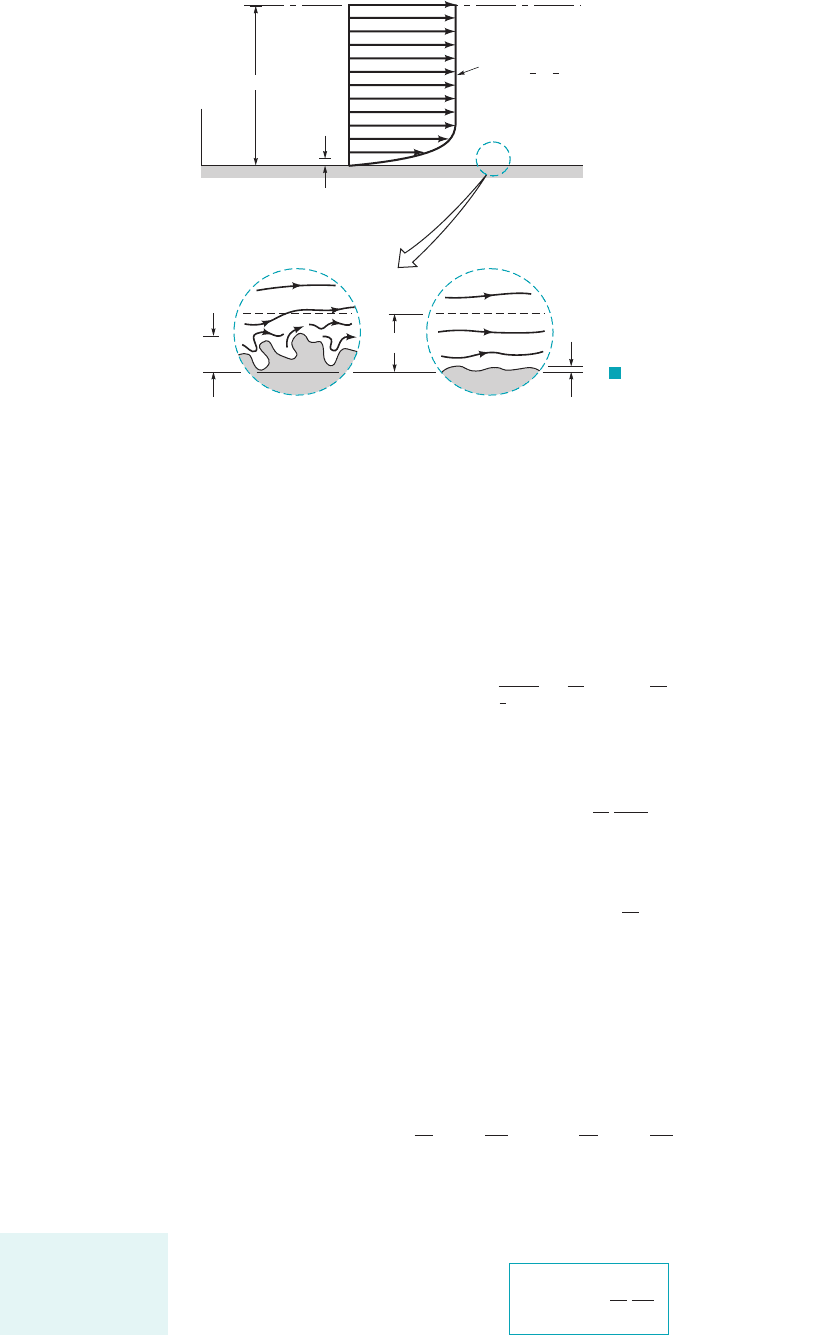
of the density than it is of viscosity. Second, we have introduced two additional dimensionless
parameters, the Reynolds number, and the relative roughness, which are not
present in the laminar formulation because the two parameters and are not important in fully
developed laminar pipe flow.
As was done for laminar flow, the functional representation can be simplified by imposing
the reasonable assumption that the pressure drop should be proportional to the pipe length. 1Such
a step is not within the realm of dimensional analysis. It is merely a logical assumption supported
by experiments.2The only way that this can be true is if the dependence is factored out as
As was discussed in Section 8.2.3, the quantity is termed the friction factor, f. Thus,
for a horizontal pipe
(8.33)
where
For laminar fully developed flow, the value of f is simply independent of For tur-
bulent flow, the functional dependence of the friction factor on the Reynolds number and the relative
roughness, is a rather complex one that cannot, as yet, be obtained from a theoret-
ical analysis. The results are obtained from an exhaustive set of experiments and usually presented
in terms of a curve-fitting formula or the equivalent graphical form.
From Eq. 5.89 the energy equation for steady incompressible flow is
where is the head loss between sections 112and 122. With the assumption of a constant diame-
ter so that horizontal pipe with fully developed flow this
becomes which can be combined with Eq. 8.33 to give
(8.34)h
L major
⫽ f
/
D
V
2
2g
¢p ⫽ p
1
⫺ p
2
⫽ gh
L
,
1a
1
⫽ a
2
2,1z
1
⫽ z
2
2V
1
⫽ V
2
2,1D
1
⫽ D
2
h
L
p
1
g
⫹ a
1
V
1
2
2g
⫹ z
1
⫽
p
2
g
⫹ a
2
V
2
2
2g
⫹ z
2
⫹ h
L
f ⫽ f1Re, e
Ⲑ
D2,
e
Ⲑ
D.f ⫽ 64
Ⲑ
Re,
f ⫽ f aRe,
e
D
b
¢p ⫽ f
/
D
rV
2
2
¢pD
Ⲑ
1/rV
2
Ⲑ
22
¢p
1
2
rV
2
⫽
/
D
f aRe,
e
D
b
/
Ⲑ
D
er
e
Ⲑ
D,Re ⫽ rVD
Ⲑ
m,
8.4 Dimensional Analysis of Pipe Flow 411
F I G U R E 8.19 Flow in the
viscous sublayer near rough and smooth
walls.
R = D/2
δ
s
δ
s
Viscous sublayer
Velocity
profile,
u = u(y)
y
x
∋
∋
Smooth wallRough wall
or
The major head
loss in pipe flow is
given in terms of
the friction factor.
JWCL068_ch08_383-460.qxd 9/23/08 10:52 AM Page 411
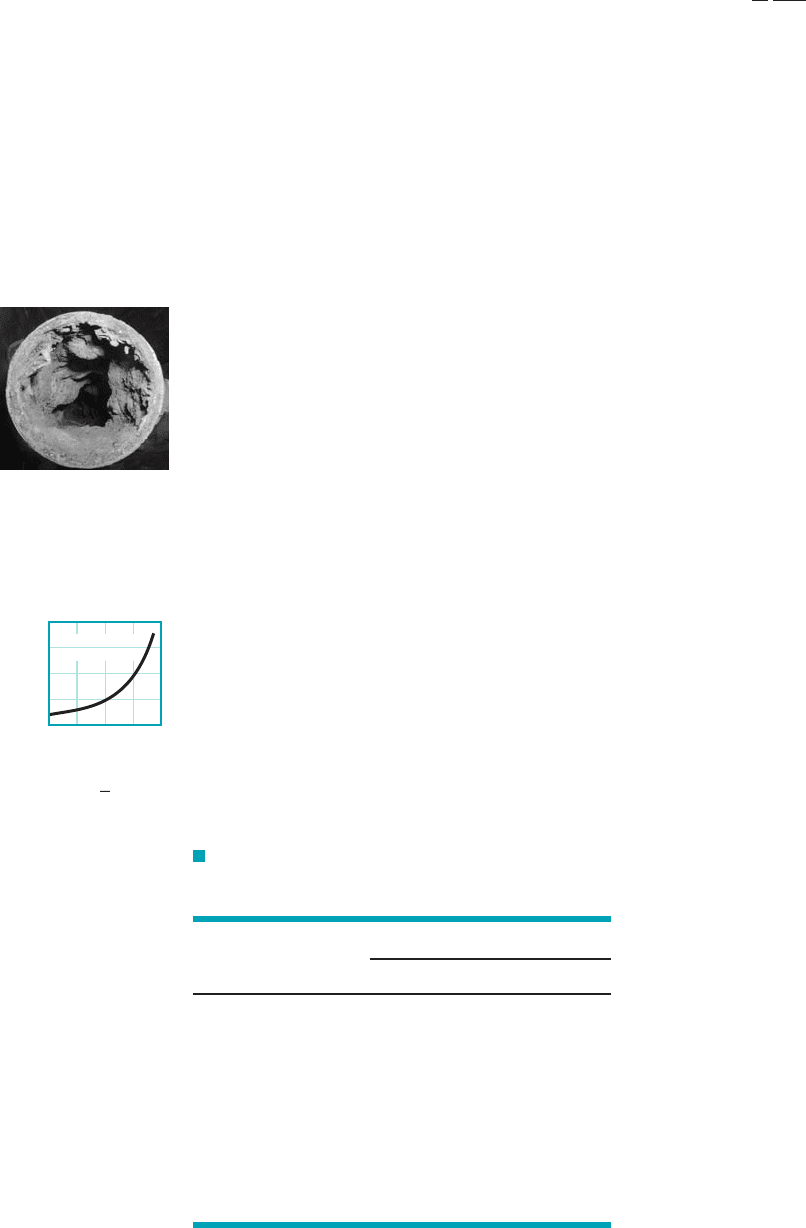
Equation 8.34, called the Darcy–Weisbach equation, is valid for any fully developed, steady, in-
compressible pipe flow—whether the pipe is horizontal or on a hill. On the other hand, Eq. 8.33
is valid only for horizontal pipes. In general, with the energy equation gives
Part of the pressure change is due to the elevation change and part is due to the head loss associ-
ated with frictional effects, which are given in terms of the friction factor, f.
It is not easy to determine the functional dependence of the friction factor on the Reynolds
number and relative roughness. Much of this information is a result of experiments conducted by
J. Nikuradse in 1933 1Ref. 62and amplified by many others since then. One difficulty lies in the
determination of the roughness of the pipe. Nikuradse used artificially roughened pipes produced
by gluing sand grains of known size onto pipe walls to produce pipes with sandpaper-type sur-
faces. The pressure drop needed to produce a desired flowrate was measured and the data were
converted into the friction factor for the corresponding Reynolds number and relative roughness.
The tests were repeated numerous times for a wide range of Re and to determine the
dependence.
In commercially available pipes the roughness is not as uniform and well defined as in the
artificially roughened pipes used by Nikuradse. However, it is possible to obtain a measure of the
effective relative roughness of typical pipes and thus to obtain the friction factor. Typical rough-
ness values for various pipe surfaces are given in Table 8.1. Figure 8.20 shows the functional de-
pendence of f on Re and and is called the Moody chart in honor of L. F. Moody, who, along
with C. F. Colebrook, correlated the original data of Nikuradse in terms of the relative roughness
of commercially available pipe materials. It should be noted that the values of do not neces-
sarily correspond to the actual values obtained by a microscopic determination of the average
height of the roughness of the surface. They do, however, provide the correct correlation for
It is important to observe that the values of relative roughness given pertain to new, clean
pipes. After considerable use, most pipes 1because of a buildup of corrosion or scale2may have a
relative roughness that is considerably larger 1perhaps by an order of magnitude2than that given.
As shown by the figure in the margin, very old pipes may have enough scale buildup to not only
alter the value of but also to change their effective diameter by a considerable amount.
The following characteristics are observed from the data of Fig. 8.20. For laminar flow,
which is independent of relative roughness. For turbulent flows with very large Reynolds
numbers, which, as shown by the figure in the margin, is independent of the Reynolds
number. For such flows, commonly termed completely turbulent flow 1or wholly turbulent flow2, the
laminar sublayer is so thin 1its thickness decreases with increasing Re2that the surface roughness
completely dominates the character of the flow near the wall. Hence, the pressure drop required is a
f ⫽ f1e
Ⲑ
D2,
f ⫽ 64
Ⲑ
Re,
e
f ⫽ f1Re, e
Ⲑ
D2.
e
Ⲑ
D
e
Ⲑ
D
f ⫽ f1Re, e
Ⲑ
D2
e
Ⲑ
D
p
1
⫺ p
2
⫽ g1z
2
⫺ z
1
2⫹ gh
L
⫽ g1z
2
⫺ z
1
2⫹ f
/
D
rV
2
2
V
1
⫽ V
2
412 Chapter 8 ■ Viscous Flow in Pipes
TABLE 8.1
Equivalent Roughness for New Pipes [From Moody
(Ref. 7) and Colebrook (Ref. 8)]
Equivalent Roughness,
Pipe Feet Millimeters
Riveted steel 0.003–0.03 0.9–9.0
Concrete 0.001–0.01 0.3–3.0
Wood stave 0.0006–0.003 0.18–0.9
Cast iron 0.00085 0.26
Galvanized iron 0.0005 0.15
Commercial steel
or wrought iron 0.00015 0.045
Drawn tubing 0.000005 0.0015
Plastic, glass 0.0 1smooth2 0.0 1smooth2
E
0.00001
0.0001
0.001
0.01
0.1
0.08
0.06
Completely
turbulent flow
0.04
0.02
0
f
e
D
JWCL068_ch08_383-460.qxd 9/23/08 10:53 AM Page 412
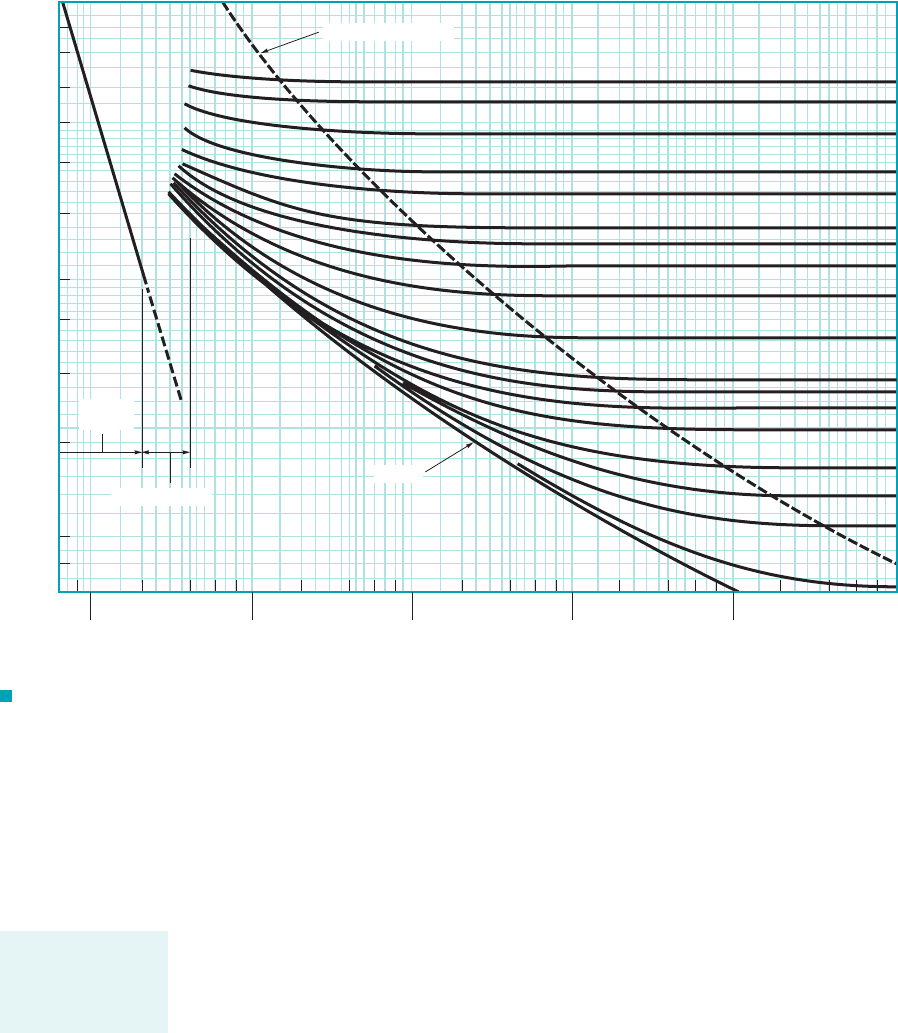
result of an inertia-dominated turbulent shear stress rather than the viscosity-dominated laminar shear
stress normally found in the viscous sublayer. For flows with moderate values of Re, the friction fac-
tor is indeed dependent on both the Reynolds number and relative roughness— The
gap in the figure for which no values of f are given 1the range2is a result of the
fact that the flow in this transition range may be laminar or turbulent 1or an unsteady mix of both2
depending on the specific circumstances involved.
Note that even for smooth pipes the friction factor is not zero. That is, there is a
head loss in any pipe, no matter how smooth the surface is made. This is a result of the no-slip
boundary condition that requires any fluid to stick to any solid surface it flows over. There is al-
ways some microscopic surface roughness that produces the no-slip behavior 1and thus 2on
the molecular level, even when the roughness is considerably less than the viscous sublayer thick-
ness. Such pipes are called hydraulically smooth.
Various investigators have attempted to obtain an analytical expression for Note
that the Moody chart covers an extremely wide range in flow parameters. The nonlaminar region cov-
ers more than four orders of magnitude in Reynolds number—from to Ob-
viously, for a given pipe and fluid, typical values of the average velocity do not cover this range. How-
ever, because of the large variety in pipes 1D2, fluids and and velocities 1V2, such a wide range
in Re is needed to accommodate nearly all applications of pipe flow. In many cases the particular pipe
flow of interest is confined to a relatively small region of the Moody chart, and simple semiempirical
expressions can be developed for those conditions. For example, a company that manufactures cast
iron water pipes with diameters between 2 and 12 in. may use a simple equation valid for their con-
ditions only. The Moody chart, on the other hand, is universally valid for all steady, fully developed,
incompressible pipe flows.
m2,1r
Re 10
8
.Re 4 10
3
f1Re, e
D2.f
f 0
1e 02
2100 6 Re 6 4000
f f1Re, e
D2.
8.4 Dimensional Analysis of Pipe Flow 413
For any pipe, even
smooth ones, the
head loss is not
zero.
F I G U R E 8.20 Friction factor as a function of Reynolds number and relative roughness for round pipes—the Moody
chart. (Data from Ref. 7 with permission.)
Transition range
Laminar
flow
Smooth
Wholly turbulent flow
0.1
0.09
0.08
0.07
0.06
0.05
0.04
0.03
0.025
0.02
0.015
0.01
0.009
0.008
10
3
2(10
3
) 4 68
10
4
2(10
4
) 4 68
10
5
2(10
5
) 4 68
10
6
2(10
6
) 4 68
10
7
2(10
7
) 4 68
0.05
0.04
0.03
0.02
0.015
0.01
0.008
0.006
0.004
0.002
0.001
0.0008
0.0006
0.0004
0.0002
0.0001
0.00005
0.00001
f
Re =
VD
_____
μ
ρ
__
D
∋
JWCL068_ch08_383-460.qxd 9/23/08 10:53 AM Page 413

The following equation from Colebrook is valid for the entire nonlaminar range of the Moody
chart
(8.35a)
In fact, the Moody chart is a graphical representation of this equation, which is an empirical
fit of the pipe flow pressure drop data. Equation 8.35 is called the Colebrook formula. A dif-
ficulty with its use is that it is implicit in the dependence of f. That is, for given conditions
it is not possible to solve for f without some sort of iterative scheme. With the
use of modern computers and calculators, such calculations are not difficult. A word of cau-
tion is in order concerning the use of the Moody chart or the equivalent Colebrook formula.
Because of various inherent inaccuracies involved 1uncertainty in the relative roughness, un-
certainty in the experimental data used to produce the Moody chart, etc.2, the use of several
place accuracy in pipe flow problems is usually not justified. As a rule of thumb, a 10% ac-
curacy is the best expected. It is possible to obtain an equation that adequately approximates
the Colebrook兾Moody chart relationship but does not require an iterative scheme. For exam-
ple, an alternate form (Ref. 34), which is easier to use, is given by
(8.35b)
where one can solve for f explicitly.
1
2f
⫽⫺1.8 log ca
e
Ⲑ
D
3.7
b
1.11
⫹
6.9
Re
d
1Re and e
Ⲑ
D2,
1
1f
⫽⫺2.0 log a
e
Ⲑ
D
3.7
⫹
2.51
Re1f
b
414 Chapter 8 ■ Viscous Flow in Pipes
The turbulent por-
tion of the Moody
chart is represented
by the Colebrook
formula.
GIVEN Air under standard conditions flows through a 4.0-mm-
diameter drawn tubing with an average velocity of
For such conditions the flow would normally be turbulent. How-
ever, if precautions are taken to eliminate disturbances to the flow
1the entrance to the tube is very smooth, the air is dust free, the tube
does not vibrate, etc.2, it may be possible to maintain laminar flow.
V ⫽ 50 m
Ⲑ
s.
FIND (a) Determine the pressure drop in a 0.1-m section of
the tube if the flow is laminar.
(b) Repeat the calculations if the flow is turbulent.
S
OLUTION
Comparison of Laminar or Turbulent Pressure Drop
COMMENT Note that the same result is obtained from Eq. 8.8:
(b) If the flow were turbulent, then where
from Table 8.1, so that
From the Moody chart with
we obtain Thus, the pressure
drop in this case would be approximately
or
(Ans)
¢p ⫽ 1.076 kPa
¢p ⫽ f
/
D
1
2
rV
2
⫽ 10.0282
10.1 m2
10.004 m2
1
2
11.23 kg
Ⲑ
m
3
2150 m
Ⲑ
s2
2
f ⫽ 0.028.10
4
and e
Ⲑ
D ⫽ 0.000375
Re ⫽ 1.37 ⫻4.0 mm ⫽ 0.000375.
e
Ⲑ
D ⫽ 0.0015 mm
Ⲑ
e ⫽ 0.0015 mm
f ⫽ f1Re, e
Ⲑ
D2,
⫽ 179 N
Ⲑ
m
2
⫽
3211.79 ⫻ 10
⫺5
N
#
s
Ⲑ
m
2
210.1 m2150 m
Ⲑ
s2
10.004 m2
2
¢p ⫽
32m/
D
2
V
E
XAMPLE 8.5
Under standard temperature and pressure conditions the density
and viscosity are and
Thus, the Reynolds number is
which would normally indicate turbulent flow.
(a) If the flow were laminar, then
and the pressure drop in a 0.1-m-long horizontal section
of the pipe would be
or
(Ans)
¢p ⫽ 0.179 kPa
⫽ 10.004672
10.1 m2
10.004 m2
1
2
11.23 kg
Ⲑ
m
3
2150 m
Ⲑ
s2
2
¢p ⫽ f
/
D
1
2
rV
2
0.00467
f ⫽ 64
Ⲑ
Re ⫽ 64
Ⲑ
13,700 ⫽
Re ⫽
rVD
m
⫽
11.23 kg
Ⲑ
m
3
2150 m
Ⲑ
s210.004 m2
1.79 ⫻ 10
⫺5
N
#
s
Ⲑ
m
2
⫽ 13,700
N
#
s
Ⲑ
m
2
.
m ⫽ 1.79 ⫻ 10
⫺5
r ⫽ 1.23 kg
Ⲑ
m
3
JWCL068_ch08_383-460.qxd 9/23/08 10:53 AM Page 414

8.4.2 Minor Losses
As discussed in the previous section, the head loss in long, straight sections of pipe, the major losses,
can be calculated by use of the friction factor obtained from either the Moody chart or the Colebrook
equation. Most pipe systems, however, consist of considerably more than straight pipes. These addi-
tional components 1valves, bends, tees, and the like2add to the overall head loss of the system. Such
losses are generally termed minor losses, with the corresponding head loss denoted In this
section we indicate how to determine the various minor losses that commonly occur in pipe systems.
The head loss associated with flow through a valve is a common minor loss. The purpose of
a valve is to provide a means to regulate the flowrate. This is accomplished by changing the geom-
etry of the system 1i.e., closing or opening the valve alters the flow pattern through the valve2,
which in turn alters the losses associated with the flow through the valve. The flow resistance or
head loss through the valve may be a significant portion of the resistance in the system. In fact,
with the valve closed, the resistance to the flow is infinite—the fluid cannot flow. Such minor
losses may be very important indeed. With the valve wide open the extra resistance due to the pres-
ence of the valve may or may not be negligible.
The flow pattern through a typical component such as a valve is shown in Fig. 8.21. It is not
difficult to realize that a theoretical analysis to predict the details of such flows to obtain the head
loss for these components is not, as yet, possible. Thus, the head loss information for essentially
all components is given in dimensionless form and based on experimental data. The most common
method used to determine these head losses or pressure drops is to specify the loss coefficient,
which is defined as
K
L
⫽
h
L minor
1V
2
Ⲑ
2g2
⫽
¢p
1
2
rV
2
K
L
,
h
L minor
.
8.4 Dimensional Analysis of Pipe Flow 415
COMMENT A considerable savings in effort to force the fluid
through the pipe could be realized 10.179 kPa rather than 1.076 kPa2
if the flow could be maintained as laminar flow at this Reynolds
number. In general this is very difficult to do, although laminar flow
in pipes has been maintained up to in rare instances.
An alternate method to determine the friction factor for
the turbulent flow would be to use the Colebrook formula,
Eq. 8.35a. Thus,
or
(1)
By using a root-finding technique on a computer or calculator, the
solution to Eq. 1 is determined to be in agreement
1within the accuracy of reading the graph2with the Moody chart
method of
Eq. 8.35b provides an alternate form to the Colebrook formula
that can be used to solve for the friction factor directly.
This agrees with the Colebrook formula and Moody chart values ob-
tained above.
Numerous other empirical formulas can be found in the litera-
ture 1Ref. 52for portions of the Moody chart. For example, an often-
⫽ 0.0289
⫽⫺1.8 log ca
0.000375
3.7
b
1.11
⫹
6.9
1.37 ⫻ 10
4
d
1
1f
⫽⫺1.8 log ca
e
Ⲑ
D
3.7
b
1.11
⫹
6.9
Re
d
f ⫽ 0.028.
f ⫽ 0.0291,
1
1f
⫽⫺2.0 log a1.01 ⫻ 10
⫺4
⫹
1.83 ⫻ 10
⫺4
1f
b
1
1f
⫽⫺2.0 log a
e
Ⲑ
D
3.7
⫹
2.51
Re1f
b⫽⫺2.0 log a
0.000375
3.7
⫹
2.51
1.37 ⫻ 10
4
1f
b
Re ⬇ 100,000
used equation, commonly referred to as the Blasius formula, for tur-
bulent flow in smooth pipes with is
For our case this gives
which is in agreement with the previous results. Note that the
value of f is relatively insensitive to for this particular situa-
tion. Whether the tube was smooth glass or the drawn
tubing would not make much difference in the
pressure drop. For this flow, an increase in relative roughness by
a factor of 30 to 1equivalent to a commercial steel
surface; see Table 8.12would give This would repre-
sent an increase in pressure drop and head loss by a factor of
compared with that for the original drawn
tubing.
The pressure drop of 1.076 kPa in a length of 0.1 m of pipe
corresponds to a change in absolute pressure [assuming
] of approximately or
about 1%. Thus, the incompressible flow assumption on which the
above calculations 1and all of the formulas in this chapter2are based
is reasonable. However, if the pipe were 2-m long the pressure drop
would be 21.5 kPa, approximately 20% of the original pressure. In
this case the density would not be approximately constant along the
pipe, and a compressible flow analysis would be needed. Such con-
siderations are discussed in Chapter 11.
1.076
Ⲑ
101 ⫽ 0.0107,101 kPa 1abs2 at x ⫽ 0
p ⫽
0.043
Ⲑ
0.0291 ⫽ 1.48
f ⫽ 0.043.
e
Ⲑ
D ⫽ 0.0113
1e
Ⲑ
D ⫽ 0.0003752
1e
Ⲑ
D ⫽ 02
e
Ⲑ
D
f ⫽ 0.316113,7002
⫺0.25
⫽ 0.0292
f ⫽
0.316
Re
1
Ⲑ
4
Re 6 10
5
1e
Ⲑ
D ⫽ 02
Losses due to pipe
system components
are given in terms
of loss coefficients.
JWCL068_ch08_383-460.qxd 9/23/08 10:53 AM Page 415
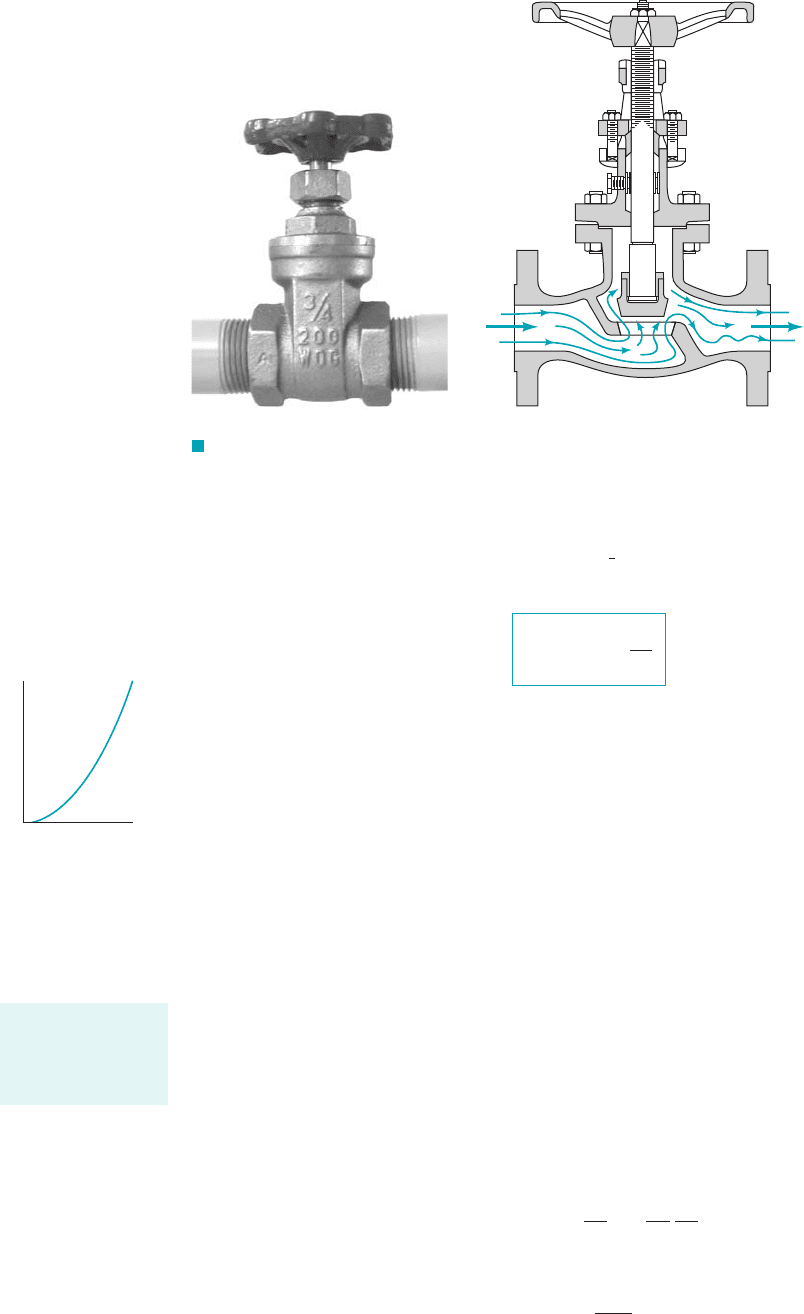
so that
or
(8.36)
The pressure drop across a component that has a loss coefficient of is equal to the dynamic
pressure, As shown by Eq. 8.36 and the figure in the margin, for a given value of K
L
the
head loss is proportional to the square of the velocity.
The actual value of is strongly dependent on the geometry of the component considered.
It may also be dependent on the fluid properties. That is,
where is the pipe Reynolds number. For many practical applications the Reynolds
number is large enough so that the flow through the component is dominated by inertia effects, with
viscous effects being of secondary importance. This is true because of the relatively large acceler-
ations and decelerations experienced by the fluid as it flows along a rather curved, variable area
1perhaps even torturous2path through the component 1see Fig. 8.212. In a flow that is dominated by
inertia effects rather than viscous effects, it is usually found that pressure drops and head losses cor-
relate directly with the dynamic pressure. This is the reason why the friction factor for very large
Reynolds number, fully developed pipe flow is independent of the Reynolds number. The same con-
dition is found to be true for flow through pipe components. Thus, in most cases of practical inter-
est the loss coefficients for components are a function of geometry only,
Minor losses are sometimes given in terms of an equivalent length, In this terminology,
the head loss through a component is given in terms of the equivalent length of pipe that would
produce the same head loss as the component. That is,
or
/
eq
⫽
K
L
D
f
h
L minor
⫽ K
L
V
2
2g
⫽ f
/
eq
D
V
2
2g
/
eq
.
K
L
⫽ f1geometry2.
Re ⫽ rVD
Ⲑ
m
K
L
⫽ f1geometry, Re2
K
L
rV
2
Ⲑ
2.
K
L
⫽ 1
h
L minor
⫽ K
L
V
2
2g
¢p ⫽ K
L
1
2
rV
2
416 Chapter 8 ■ Viscous Flow in Pipes
QQ
(b)
F I G U R E 8.21 Flow through a valve.
(a)
~ V
2
h
L, minor
h
L, minor
V
For most flows the
loss coefficient is
independent of the
Reynolds number.
JWCL068_ch08_383-460.qxd 9/23/08 10:53 AM Page 416
